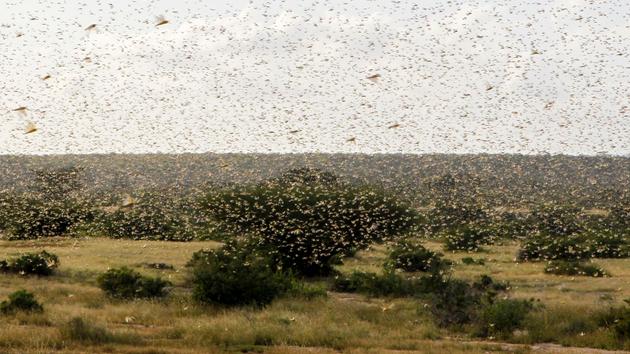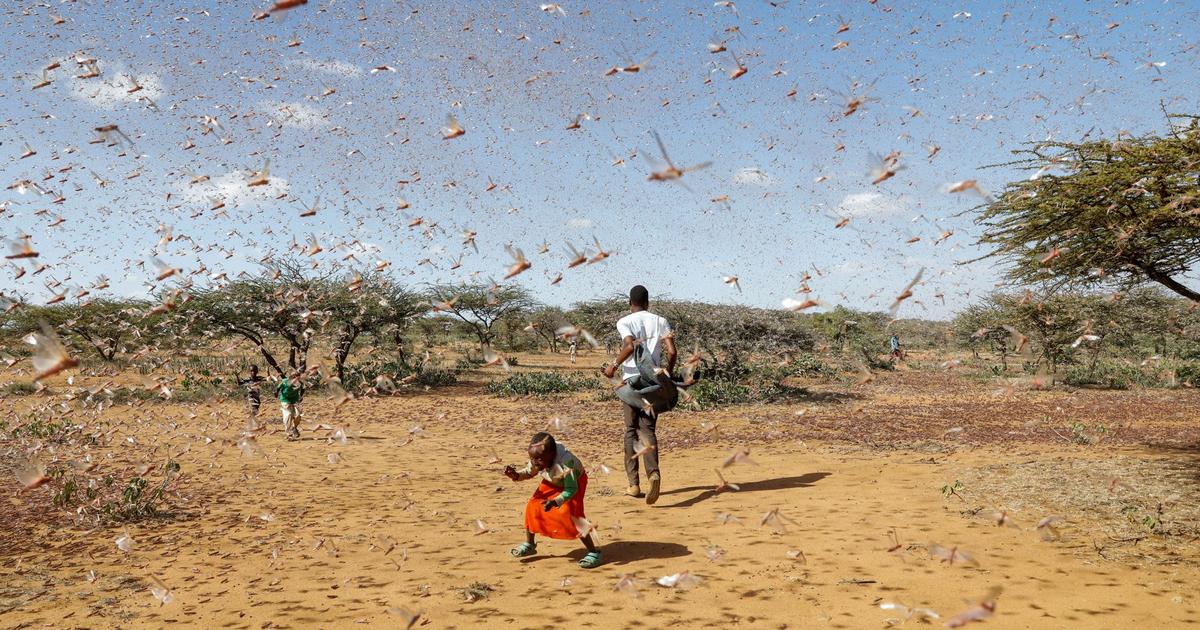Locust swarms of historic magnitude, totaling several billion insects, have been devastating large areas of East Africa for several weeks, following extreme climatic variations which could prove catastrophic for an already stricken region. by drought and floods. Thick clouds of hungry locusts have spread from Ethiopia and Somalia to Kenya and Uganda since Sunday, February 9. The United Nations Agency for Agriculture and Food (FAO) has estimated that only one of these swarms covered an area of 2,400 km2, the size of Luxembourg.
Read also: Locusts, the last plague in East Africa burdened by climatic variations
Le Figaro details the causes and consequences of the proliferation of these voracious insects for local populations.
● How big is the phenomenon?
Such a swarm would contain some 200 billion locusts - and each devours the equivalent of its own weight (two grams) each day, making a total of 400,000 tonnes of food. It is capable of traveling 150 kilometers per day and devastating the livelihoods of rural populations in their frantic race for food and reproduction. Ethiopia and Somalia - where authorities have declared a national emergency - had not seen swarms of locusts of such magnitude in 25 years, and Kenya had not faced a locust threat such strength for 70 years, according to the FAO.
If nothing is done, the number of insect pests "could be multiplied by 500 by the month of June" , invading South Sudan, devastating crops in its path, in areas already very vulnerable, has put warns the UN agency. This could cause “a major food security problem , ” said Guleid Artan of the Center for Climate Prediction and Applications (ICPAC), part of the regional organization Igad, on Friday at a press conference in Nairobi.
Le Figaro
If the phenomenon were to worsen, over a year or more, it would become an "invasion" of locusts. There were six "invasions" of locusts in the 20th century, the last of which occurred in 1987-89.
● What are the causes of this proliferation?
For Guleid Artan of the Center for Forecasting and Applications in Climate (ICPAC), the current invasion is the latest symptom of a series of extreme climatic variations in East Africa in 2019, which began with a severe drought and ended with devastating rains and floods, which left hundreds of people dead. These extreme conditions are attributed to the “Indian Ocean dipole” , a climatic phenomenon created by the difference in temperature on the sea surface between the eastern and western zones of the Indian Ocean.
Read also: East Africa: locust infestations threaten food security
Scientists say they haven't observed a dipole of such intensity for years, if not decades. “We know that East Africa is one of the areas most vulnerable to climate change. This region will experience new extreme variations ” , underlined Guleid Artan. One of the experts participating in the press conference in Nairobi had to reassure the audience and explained that the invasion of locusts after the drought and floods were not the harbingers of the Apocalypse announced by the Bible.
● What is the damage?
A road infested with locusts near Nairobi, Kenya. TONY KARUMBA / AFP
The giant swarms entered Kenya in December, devastating the prairie in the north and center of the country. If the farmers have been relatively spared, their fields having already been harvested, the breeders are hit hard by an invasion which destroys the livelihood of their animals. Its impact is all the greater since the breeders had just suffered three years of drought and it usually takes up to five years to recover from such an ordeal. If the threat of locusts has not been brought under control by the start of the next planting season around March, farmers could see their fields wiped out.
Ten million of these people live in areas affected by locusts
Mark Lowcock, Under-Secretary-General for Humanitarian Affairs, United NationsOn the ground, the consequences are already visible. According to the NGO Acted, 65% of agricultural production in Madera County, Kenya, is affected by this invasion. In Somalia, in the Gedo region, "between 35% and 60% of the agricultural production areas have been damaged since the beginning of this crisis," continues the NGO, causing a spike in food prices. In Ethiopia, the Libien area, made up of 70% farmers and ranchers, was also affected by this invasion, says Acted.
UN Under-Secretary-General for Humanitarian Affairs Mark Lowcock on Monday (February 10th) expressed deep concern over the swarms of locusts that are developing in East Africa, calling on the international community to help countries concerned. “There are 13 million people in these affected countries who have difficulty accessing food. Ten million of these people live in areas affected by locusts, " he said at a press conference at UN headquarters. Stating that he had recently released $ 10 million for this disaster recently, the UN official warned that "if a rapid response" does not occur, the international community will face "a huge problem later in the year." 'year' .
● How to fight against this invasion?
Faced with the threat of giant swarms that darken the sky and devastate the vegetation, Kenyans have used all possible artisanal means to hunt them, waving sticks, striking on cans or even opening fire with rifles . In vain. Kenya has five planes that disperse pesticides on swarms, said Stephen Njoka, director of the subregional body that monitors locusts in East Africa (the Desert Locust Control Organization for Eastern Africa), based in Nairobi.
Read also: Global warming: Africa relies on technology
It ensures that the chemicals used are not harmful to human health and that the authorities are doing their best to limit damage to other insects, including pollinators. Similar operations are taking place in Ethiopia and Somalia, but in the latter country they are sometimes hampered by insecurity in certain regions, according to the FAO. The United Nations Agency for Agriculture and Food (FAO) had estimated at the end of January at “76 million dollars” the cost of a plan to fight against locusts. "So far, we have only had $ 20 million ," he said.
"This new disaster does not bode well for 2020. The unpredictable climate in 2019 and in the previous decade has already seriously eroded the ability of families to recover from the crisis," worries Ian Vale, Africa regional director for East and South of the Save the Children organization. For his part, Jean-Baptiste Héral, Country Director for Acted Horn of Africa, recalls that this new scourge "could worsen hunger and malnutrition in a region where 25.5 million people are already in serious food insecurity "








